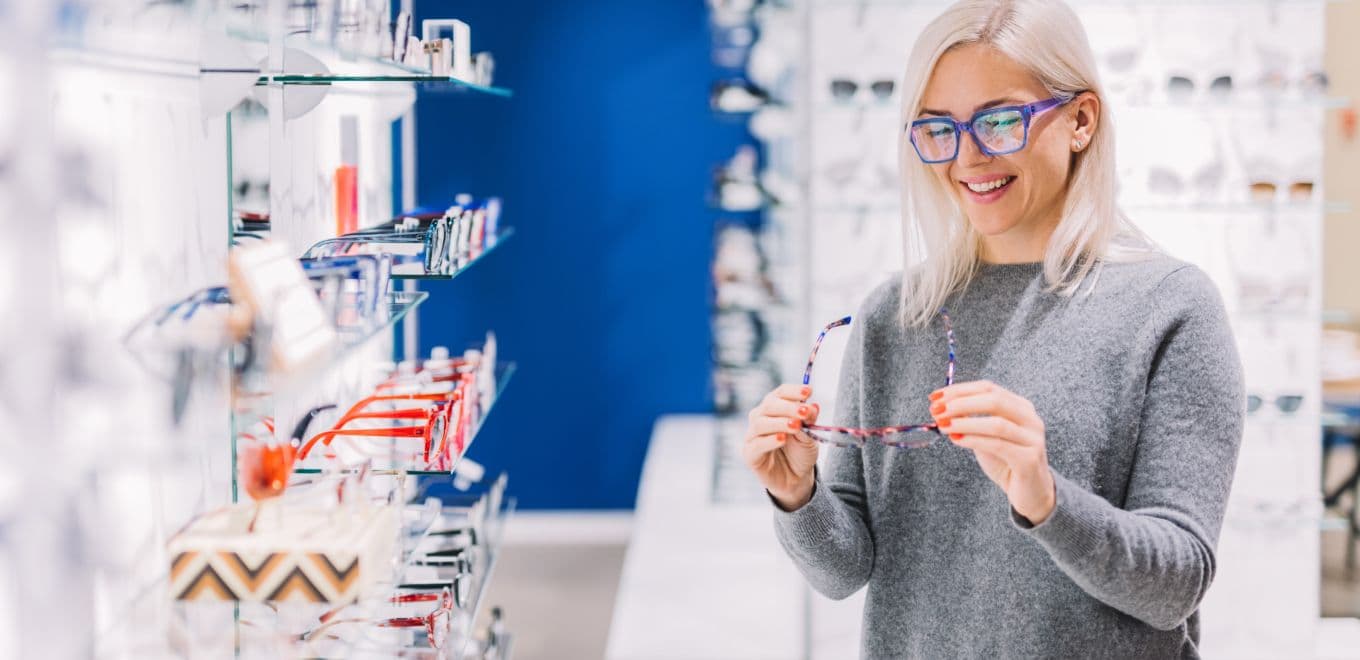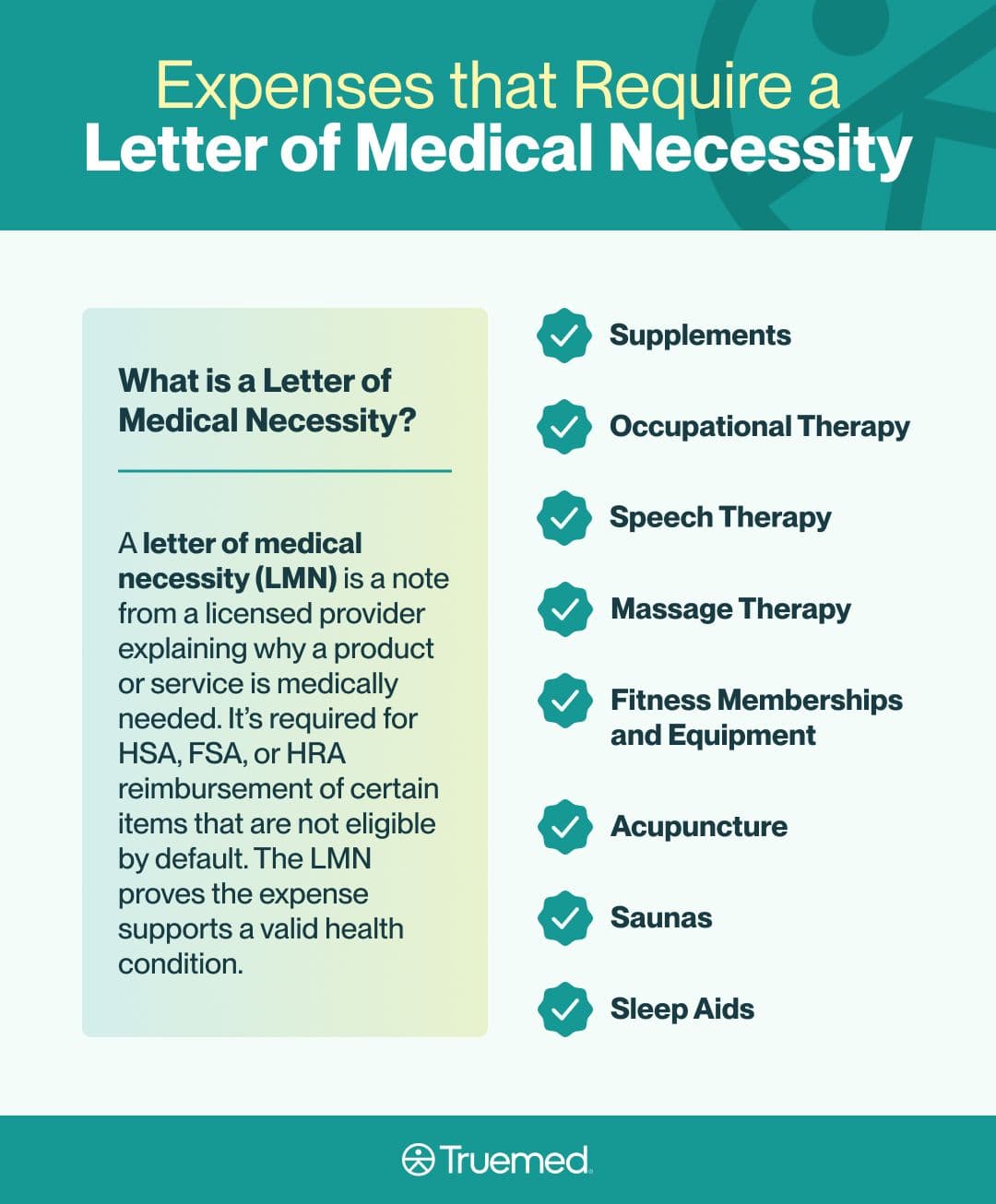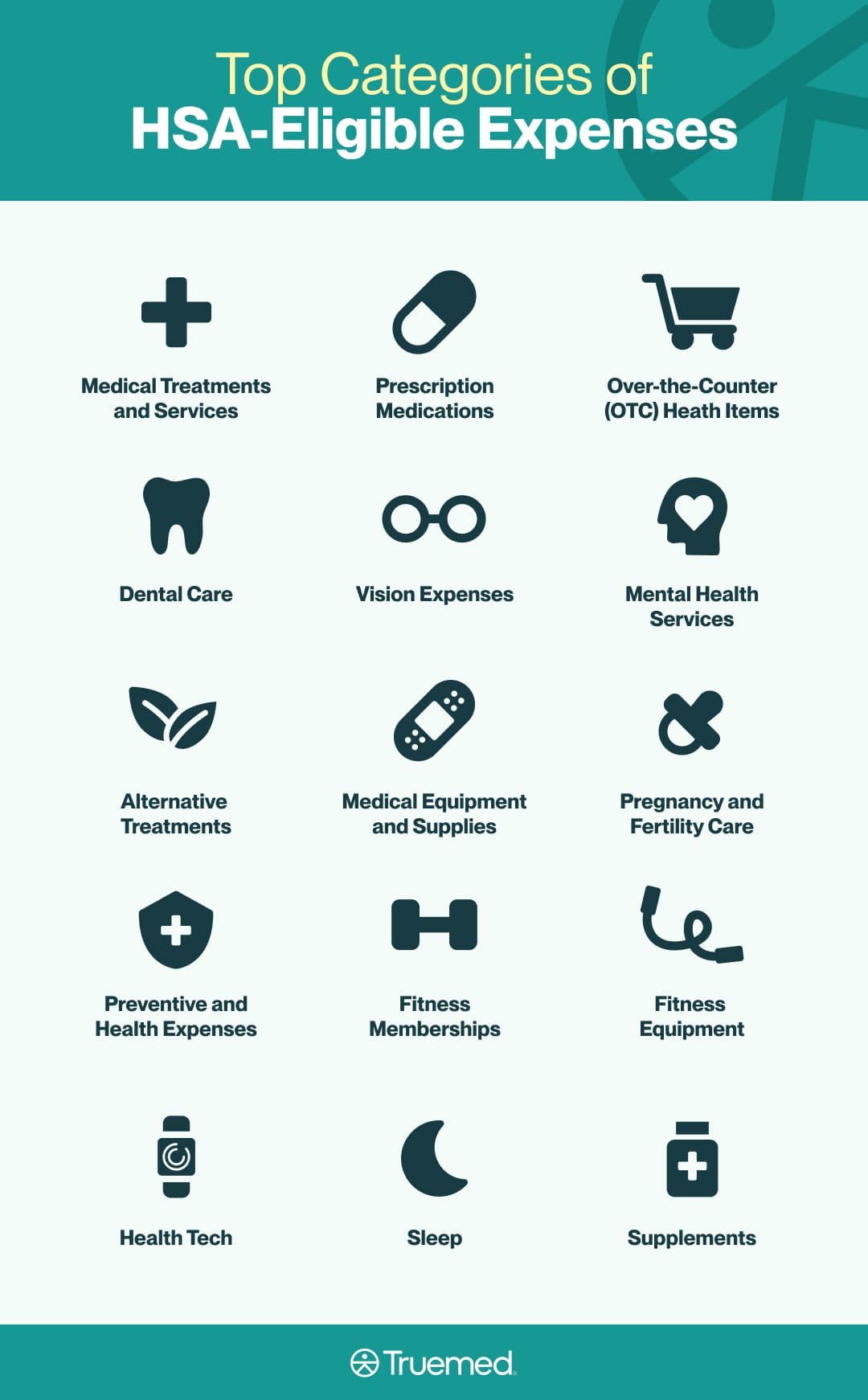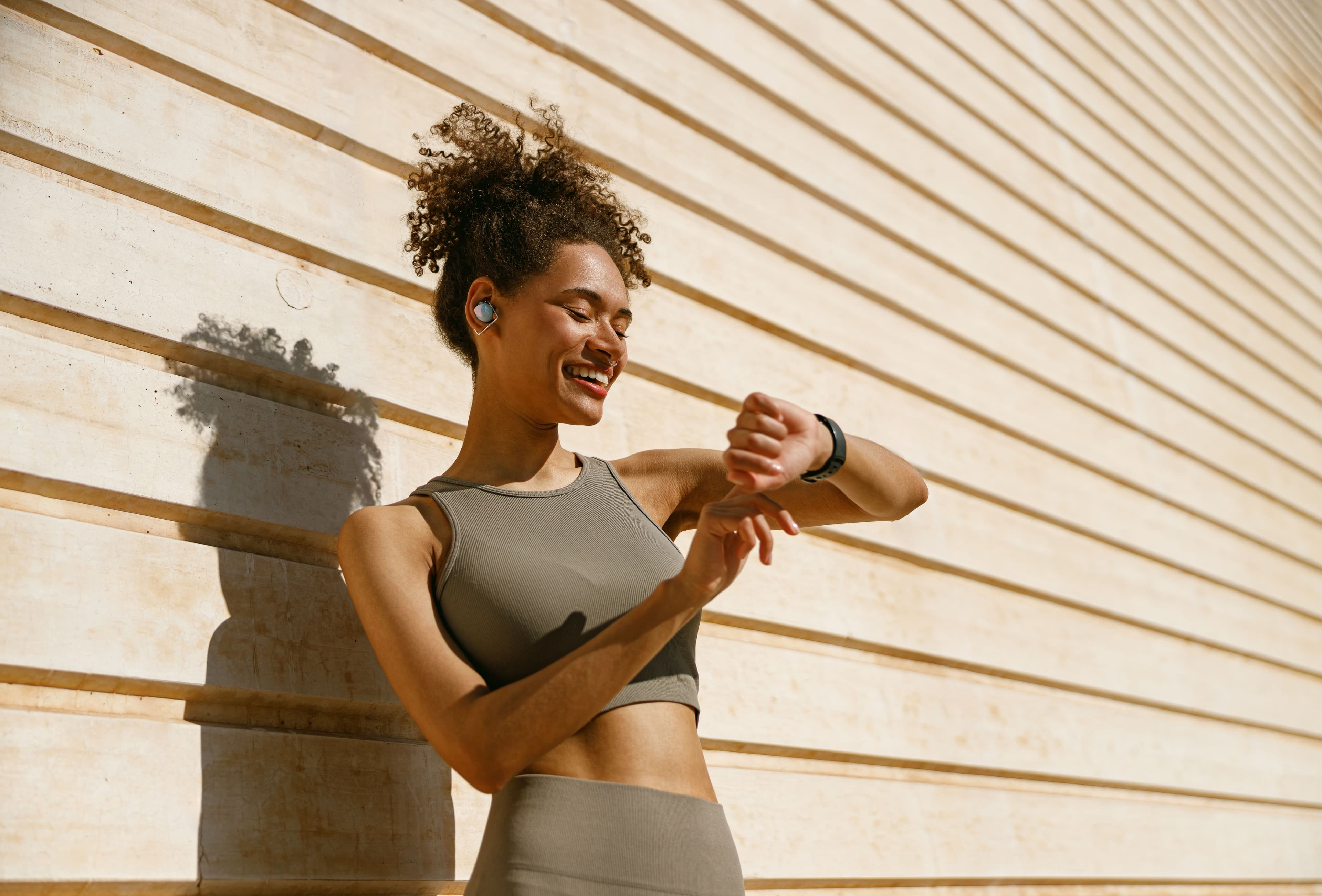The Ultimate List of 100+ HSA-/FSA-Eligible Expenses
Author:Kathleen Ferraro
Reviewed By:Michaela Robbins, DNP
Published:
July 08, 2025

HSA vs. FSA: 2025 Comparison Guide & Chart
Think your health savings account (HSA) is just for doctor visits and prescriptions? Think again. An HSA lets you use pre-tax dollars to pay for hundreds of health-supportive expenses, including things like therapy, supplements, sleep tech, and even gym memberships (with the right paperwork). The trick is knowing what qualifies, what doesn’t, and how to navigate gray areas like products that need a letter of medical necessity (LMN).
A health savings account (HSA) helps you save money on healthcare by letting you use pre-tax dollars to pay for HSA-eligible expenses—things like doctor visits, prescriptions, and a whole lot more. Translation: HSAs lower your taxable income and your out-of-pocket healthcare costs at the same time. Flexible spending accounts (FSAs), a cousin of HSAs, work similarly.
But here’s what most people don’t realize: You may be eligible to use your HSA funds for way more than just doctor visit copays and prescriptions. We’re talking everything from mental health care to red light therapy and even fitness trackers, so long as it’s needed to treat or manage a medical condition.
Knowing what counts as an FSA- or HSA-eligible expense can help you stretch your health dollars further, and that’s exactly what this guide is here to do. We break down more than 100 HSA-approved items by category so you can see what qualifies and learn how to get the most out of every tax-free dollar.
Understanding HSA Eligibility
To qualify as an HSA-eligible expense, a product or service has to primarily serve a medical purpose. In other words, things you can buy with an HSA must help diagnose, treat, prevent, or manage a health condition that you have, not just make you feel good, ease everyday stress, or support general health.
The IRS defines this more broadly than you may expect, so eligible expenses range from doctor visits and surgeries to mental health therapy, dental care, and prescription medications. But here’s the twist: Plenty of preventive and other health-focused purchases also count, especially if you have a letter of medical necessity (LMN) from your doctor that shows the item or service is part of a specific treatment or prevention plan.
The bottom line: If it’s tied to improving, maintaining, or supporting your health in a medically recognized way—and you’ve got documentation to back it up—there’s a good chance it qualifies. Let your health goals lead the way, just make sure the IRS rules are riding shotgun.
Expenses that Typically Require a Letter of Medical Necessity
A letter of medical necessity is a document from a healthcare provider explaining why a product or service is medically necessary for a patient’s treatment or health condition,” says Brian Miller, licensed insurance agent and COO and co-founder of OneHealth. “It’s often required to approve HSA, FSA, or HRA reimbursements for certain expenses.”
In other words, it’s your ticket to unlocking HSA eligibility for health-supportive items that aren’t traditionally seen as "medical.” The LMN proves they’re being used for a valid, provider-supported reason. Examples of typically LMN-required purchases include:
- Supplements
- Occupational therapy
- Speech therapy
- Massage therapy
- Fitness memberships and equipment
- Saunas
- Sleep aids
- Acupuncture
On the other hand, standard medical services (think doctor visit copays, necessary surgeries, or dental and vision checkups) and prescribed medications generally don’t require an LMN, says Miller.
Need an LMN? We make it easy. Find your product in Truemed’s marketplace, and we’ll walk you through the steps.

Top Categories of HSA-Eligible Expenses
So, what can you often buy with an HSA or FSA? Below, we’ve organized 100+ items that are typically HSA-eligible into easy-to-browse categories, from traditional medical care to unexpected health tools that might surprise you. Use this list to double-check what you’ve already bought, plan smarter purchases in the future, or finally put that HSA card to use beyond the pharmacy aisle.
Just keep this golden rule in mind: “To qualify, equipment must be primarily for medical use,” says Miller, so make sure your purchases meet that key requirement.
Medical Treatments and Services
1. Health insurance premiums
2. Primary care visits
3. Specialist consultations (like a visit to a dermatologist or cardiologist)
4. Surgery (inpatient or outpatient)
5. Lab tests and bloodwork
6. Imaging (like MRIs, X-rays, and CT scans)
7. Physical therapy
8. Urgent care and ER visits
9. Ambulance rides
10. Hospital stays
11. Telehealth consultations
12. Nursing homes and long-term care
Prescription Medications
All prescribed drugs (both name-brand and generic) are HSA-eligible. Here are some common examples:
13. Antibiotics
14. Asthma inhalers
15. Birth control
16. Antidepressants
17. Hormone therapy
18. Insulin and diabetic medications
Over-the-Counter (OTC) Health Items
19. Pain relievers (like ibuprofen and acetaminophen)
20. Allergy medicines (like Claritin and Zyrtec)
21. Heartburn and digestive aids
22. Cold and flu remedies
23. Menstrual care products (like pads, tampons, and cups)
24. First aid supplies (like bandages and antiseptics)
25. Bug bite relief products
Dental Care
26. Cleanings and exams
27. Fillings and root canals
28. Orthodontics (like braces or Invisalign)
29. Wisdom teeth removal
30. Dentures
31. Prescription toothpaste (Prevident)
Vision Expenses
32. Eye exams
33. Prescription glasses and lenses
34. Lens cloths and cleaners
35. Contact lenses and solution
36. LASIK and PRK surgery
Mental Health Services
37. Therapy and counseling
38. Psychiatry appointments
39. Inpatient mental health treatment
40. Prescribed mental health medications (like antidepressants or antipsychotics)
Alternative and Complementary Treatments
41. Acupuncture
42. Chiropractic care
43. Naturopathic treatments (like herbal medicines)
44. Nutrition counseling
45. Massage therapy
46. Occupational therapy
47. Speech therapy
48. Pulmonary therapy
49. Hypnotherapy
Medical Equipment and Supplies
50. Blood pressure monitors
51. Glucose meters and testing strips
52. CPAP machines and accessories
53. Crutches, walkers, wheelchairs
54. Compression socks
55. Hearing aids
56. Heat and cold wraps
57. Nebulizers
58. Masks
59. Hand sanitizer
Pregnancy and Fertility Care
60. Prenatal vitamins
61. Childbirth classes
62. Childbirth expenses
63. Breast pumps and lactation supplies
64. Fertility treatments
65. Egg and sperm storage
66. Doula services (typically require an LMN)
Preventive and Health Expenses
67. Vaccines and immunizations
68. Health screenings (like mammograms or cholesterol tests)
69. Medically supervised smoking cessation programs
70. Medically supervised weight-loss programs
71. Skin care products (like acne spot patches, acne drying lotion, and sunscreen)
72. Colonoscopies
73. Gut microbiome tests (with LMN)
74. DNA health tests (with LMN)
75. Food sensitivity testing (with LMN)
76. Allergy testing
Fitness Memberships
78. Gym memberships
79. Personal training
80. Fitness studio memberships (like yoga, Pilates, and spin studios)
Fitness Equipment
81. Home gym accessories (like weights and resistance bands)
82. Fitness equipment (like treadmills, bikes, and rowing machines)
83. Fitness shoes (like running and cross-training shoes)
84. Fitness clothing (like leggings and athletic socks)
85. Recovery tools (like foam rollers and percussion massagers)
86. Vibration plates
Health Tech
87. Wearables and fitness trackers (like a Whoop band or Oura Ring)
88. Air purifiers
89. Blue-light blocking glasses
90. Smart scales
91. Blood oxygen monitors
92. Thermometers
93. Red-light therapy panels or masks for inflammation recovery
94. Red-light devices for skin rejuvenation
95. Health app subscriptions (like Calm or InsideTracker)
96. Bidets
97. Saunas
98. Cold plunges
99. Massage devices (like a foot massager)
Sleep
100. Sleep masks
101. Specialty mattresses or pillows
102. White noise machines
103. Weighted blankets
104. Light therapy lamps
105. Mouth tape
Supplements
106. Probiotics
107. Vitamin supplements
108. Mineral supplements (like magnesium, calcium, iron, and zinc)
109. Omega-3s
110. Digestive enzymes
111. Immunity support
112. Protein powder
113. Greens powders
114. Electrolytes and hydration mixes

Common Misunderstandings: What’s Unlikely to Be Eligible
It’s also just as important to know what doesn’t typically count as an FSA or HSA item, as misusing your funds can lead to financial penalties and taxes, says Miller. While a provider could in theory determine that one or more of the below items is medically necessary for a certain individual, and could then write a LMN for it, it’s much less likely than for the above list. Here are some common items that are not usually HSA-eligible (and why):
- Cosmetic procedures (like liposuction, facelifts, and teeth whitening): These are considered elective or purely aesthetic, not medically necessary treatments. Because HSAs cover expenses that diagnose, treat, or prevent illness, these cosmetic procedures don’t qualify, even if you feel they improve your appearance or confidence.
- Over-the-counter beauty products (unless treating a diagnosed medical condition): Everyday items like skin foundation, regular moisturizers, or shampoos are seen as personal care, not medical expenses. However, if you have a prescription or doctor’s note confirming a medical condition—such as eczema or psoriasis—then medicated creams and treatments may be eligible for reimbursement.
- Household items (like toilet paper and cleaning products): While important for hygiene, these are considered general household necessities rather than medical expenses. Even during cold or flu season, they don’t meet IRS criteria for HSA eligibility because they don’t treat or prevent specific medical conditions directly.
- Groceries and everyday food: Normal grocery purchases, including fruits, vegetables, and specialty diets, generally don’t qualify. The exception is rare cases where a doctor prescribes specific foods that don’t satisfy everyday nutritional needs and are part of a medical treatment plan. Though even then, it often requires documentation and is tightly regulated.
- Childcare: While some medical supplies for children (like diabetic testing kits or prescription eyewear) can be covered, general childcare expenses like daycare, babysitting, preschool tuition, and other non-medical care are not eligible. HSAs are designed to cover health-related costs, so routine child supervision or education expenses don’t qualify. However, a Dependent Care FSA is a separate benefit that can be used to pay for certain childcare expenses like daycare and after-school programs.
- Other types of insurance: Your health insurance premium is typically HSA-eligible. However, life insurance, medical coverage related to your car insurance, and policies for loss of life, limb, and sight are all coverages that can’t be paid for with HSA dollars.
The takeaway: HSA rules are all about intent and proper documentation. If the expense isn’t tied to a specific diagnosis or treatment—and backed up by your doctor—it probably won’t qualify.
How to Confirm Expense Eligibility
Before you swipe your HSA card or submit for reimbursement, it’s important to confirm that your purchase qualifies as an HSA-eligible expense for you, right now. The last thing you want is to assume something’s covered, only to get denied—or worse, face tax penalties or a surprise bill.
You can always check the IRS’s official list of qualified medical expenses in Publication 502 and Publication 969. These resources spell out what usually counts (and what doesn’t), and are a good baseline for understanding the rules.
But let’s be real: IRS documents aren’t exactly beach reading. And using your HSA should feel empowering, not confusing.
That’s where Truemed comes in, with tools and guides that break it all down, plus a curated marketplace that features products that have been HSA- and FSA-eligible for many individuals. You can shop confidently knowing these products will likely check the box. And if an LMN is required, Truemed can walk you through how to get one.
If you’re still unsure about a specific item, contact your HSA or FSA provider, use our HSA eligibility guide, or message Truemed directly to cover your bases. Just don’t forget to hang on to your receipts and any supporting documentation (like an LMN) in case you need to justify your purchase during the reimbursement process or tax season.
If you’re only using your HSA to pay for doctor’s visits and prescriptions, you’re leaving money on the table: Your HSA might cover far more than you might think, including proactive, holistic, and health-related expenses.
Many products are eligible, though you may need documentation: Many of today’s most popular preventative health products (like supplements, fitness equipment, gym memberships, and even red light therapy) can qualify as HSA-eligible expenses, as long as you have an LMN from your doctor confirming that they’re part of your treatment or prevention plan.
Make sure your purchase is HSA-eligible before you spend: Otherwise, you could face denied claims or tax penalties. Common expenses that are typically ineligible include cosmetic procedures, beauty products, groceries, non-health insurance coverage, and childcare.
Truemed makes it easy: Truemed simplifies the LMN process, offers a curated marketplace of the most frequently HSA-eligible products, and helps you feel confident that your purchase is eligible. Truemed takes the guesswork out of the process so you can focus on your health, not navigating the fine print.
Editorial Standards
At True Medicine, Inc., we believe better health starts with trusted information. Our mission is to empower readers with accurate and accessible content grounded in peer-reviewed research, expert insight, and clinical guidance to make smarter health decisions. Every article is written or reviewed by qualified professionals and updated regularly to reflect the latest evidence. For more details on our rigorous editorial process, see here.


